Panasonic Lumix DMC-FS30 / FH20
-
-
Written by Gordon Laing
Intro
Released in January 2010 alongside the Lumix FS33, the Panasonic Lumix FS30 is an affordable 14 Megapixel super-zoom with an 8x optical zoom and 2.7 inch LCD screen. The pricier FS33 shares all the FS30 specifications, but features a 3 inch touch-screen. The FS30 and FS33 are known as the FH20 and FH22 respectively in North America.
The Lumix FS30 / FH 20 features optical image stabilisation to iron out the bumps and jitters that can cause camera shake – a feature that’s fairly indispensable on a compact with a long telephoto – and it can also shoot 720p HD video. These features make it an attractive option to shooters who want to capture more than just holiday snaps and family occasions, but the FS30 / FH20 also has plenty of features that make it a good choice for casual snappers. Its Intelligent Auto exposure mode uses scene recognition to determine the best exposure and it has face detection and a wide selection of scene modes.
With a super-wide zoom range, image stabilisation, HD video and a range of auto modes at an very affordable price point, the FS30 / FH20 looks like a compelling choice. There’s just one thing that might turn your head though – the Fujifilm FinePix JZ300 at a similar price and with a longer zoom range, but slightly lower resolution. To find out which offers the best combination of control, picture quality and ease of use we tested them head-to-head. Read on to find out which came out on top.
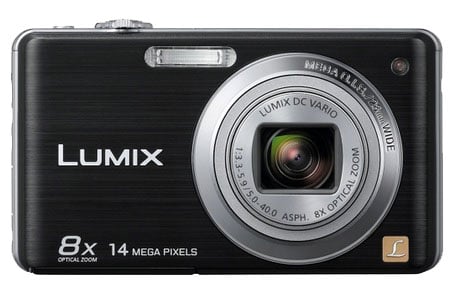 |
The Panasonic Lumix FS30 / FH20 conforms to the now familiar styling that, with minor tweaks, has been a consistent feature of the Panasonic FS and FX range compacts since early 2008. Our silver review model had a brushed metal front panel with a slightly darker silver band across the top and down either side. The FS / FH series body styling is quite angular with chamfered edges that make it look a little dated, an impression that’s reinforced by Panasonic’s preference for switches – one to turn the camera on and off and another to switch between shooting and playback modes.
It’s a comfortable camera to hold though, a task made easier by the recessed control panel on the right side section of the camera that’s about five millimetres thinner than the main body section housing the screen. There’s a dimpled thumb rest here that makes it easy to hold the camera in one hand, but you still need to take care to avoid accidental operation of the controls below it.
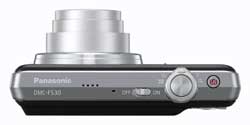 |
The camera weighs 178 grams – a little more than the Fujifilm FinePix JZ300, but at 100 x 57 x 28mm is almost the exact same physical size – so while they’re not exactly super-slim, neither are they too big to fit comfortably in a jacket or coat pocket.
A flip-up panel on the right side of the body exposes the combined A/V and USB port and two cables are supplied – a USB cable to download photos and video to your computer and an A/V cable with a composite video phono plug so you can view photos and video at standard resolution on a TV. Like the FinePix JZ300, the FS30 / FH20 doesn’t have an HDMI connector.
|
There’s a metal tripod bush located on the left corner of the base which means you’ll be able to swap cards and the battery without having to remove the camera from some tripods, but equally it can cause the camera to tilt a little when the screw is turned tight. A small clip prevents the battery from falling out when you open the battery compartment/media card cover. As well as SD and SDHC cards the FS30 / FH20 takes the latest high-speed high-capacity SDXC cards.
On the top panel you’ll find the on/off switch, a shutter release surrounded by a zoom collar and, to the right of that, the Intelligent Auto button, which toggles between the existing mode and Intelligent Auto mode. Having a button that can switch to a fully auto mode without needing to access the menu system is a good thing. Placing it right next to the shutter release is very convenient if you know what you’re doing, but will doubtless cause problems if you’re in the habit of giving your camera to passers-by, children, or anyone else to take a shot on your behalf.
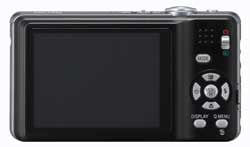 |
On the rear panel a switch, rather than the more usual button, selects shooting or playback mode. In place of a mode dial, the FS30 / FH20 has a mode button that activates a menu, from which you can then choose between ‘Normal Picture’ (what other manufacturers would call Progam Auto), a predefined ‘My Scene’ mode, any of the choices from the scene mode menu or the Motion Picture mode.
Returning to convention, a four-way control pad with a Menu-Set button at its centre doubles as both a menu navigator and one-touch selector for exposure compensation, flash, macro and self-timer functions. Two further buttons toggle the display overlays and activate the Q Menu which provides access to a range of frequently used settings including (in Normal Picture mode) image stabilization, continuous shooting, AF mode, white balance, ISO sensitivity, Image size and LCD mode (screen brightness).
The Lumix FS30 / FH20 has a built in flash which fires automatically in low light. In Normal Picture mode it can be forced on or off and there’s a red-eye mode which fires a pre-flash before the main exposure to narrow your subject’s pupils and reduce the potential for the retinal reflections that cause red-eye. The camera also has red-eye removal software that can be applied automatically during shooting.
The published range of the flash is an extravagant 5.8 metres at the wide angle lens focal length. This figure is quoted for the auto ISO setting though so doesn’t tell us much. Using the flash indoors with the camera set to 80 ISO subjects around two metres form the camera were quite poorly illuminated (see gallery images), but with the ISO set to automatic in the same conditions the camera chose an ISO sensitivity of 320 and the result were, of course, much better. This suggests that, unless you set the ISO manually (and are are prepared to put up with underexposed shots), most of your flash photos will be taken at higher ISO settings with the all the noise consequences that entails. This is pretty much the same experience we had with the Fujifilm FinePix JZ300.
The FS30 / FH20 uses a Lithium Ion battery that provides enough power from a full charge to shoot 300 pictures using the CIPA (Camera Imaging Products Association). That’s pretty good and around 25 percent more than you’ll get with the FinePix JZ300. The battery is charged outside of the camera in the supplied mains charger.
Panasonic Lumix FS30 / FH20 coverage wide |
Panasonic Lumix FS30 / FH20 coverage tele | |
 | 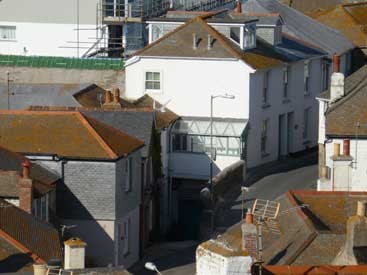 | |
| 5-40mm at 5mm (28mm equivalent) | 5-40mm at 40mm (224 mm equivalent) |
The Lumix FS30 / FH20 has an 8x optical zoom lens with a range of 5-40mm or 28-224mm in 35mm equivalent terms. When you switch the camera on the lens extends by about 20mm and the camera is ready for action in a fraction under two seconds.
While it doesn’t quite match the 10x range of the Fujufilm FinePix JZ300, the Lumix FS30 / FH20’s 8x zoom is no slouch. It starts at a very useable 28mm – great for panoramic landscapes and tight-squeeze interiors and goes all the way up to what pro photographers would call a medium telephoto. It’s also worth considering that the FS30 / FH20’s extra 2 megapixels of image resolution will get you a little closer to the Fujifilm’s maximum 280mm telephoto when its images are cropped to the same 12 Megapixel resolution.
The zoom isn’t perfectly smooth, but comes close, with just the hint of a pause mid-way. It takes about two and a half seconds to cover the full range and manages to hold the focus reasonably well during its travel. It’s possible to achieve very fine control by nudging the zoom collar with your index finger. Often the degree of travel is so small that, although the framing changes the zoom indicator bar doesn’t move. We managed 25 discrete steps zooming in and 30 zooming out. The zoom is also reasonably quiet, emitting the faintest of hums during operation.
The Lumix FS30 / FH20 employs optical image stabilization, which it calls MEGA O.I.S. This shifts the lens to compensate for camera movement and alleviate blurring caused by camera shake at slower shutter speeds. There are three modes; in Auto mode stabilization is only activated when conditions demand it, Mode 1 is continuous and Mode 2 activates stabilization on first press of the shutter release. Stabilization is automatically activated in Intelligent Auto mode, is turned off in the Starry Night scene mode, is set to mode 1 in Motion Picture mode and can be set to any mode or turned off in Normal Picture mode.
Panasonic Lumix FS30 / FH20 OIS: off / continuous | ||
 |  | |
100% crop, 5-40mm at 40mm, 1/25, 400 ISO, Normal Picture mode, OIS off. |
100% crop, 5-40mm at 40mm, 1/25, 400 ISO, Normal Picture mode, OIS on. | |
Without image stabilization you’d expect to be able to hand hold a shot with the Lumix FS30 / FH20 at its maximum focal length of 224mm at shutter speeds down to 1/224 of a second using the ‘one over the focal length’ convention. Below that and you’d expect to see evidence of camera shake.
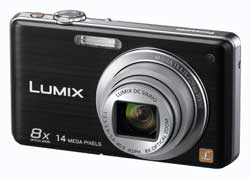 |
The two crops above are from shots taken with the Panasonic Lumix DMC-FS30 / FH20. Both were shot in Normal Picture mode with the ISO set to 400 and the camera chose an exposure of 1/25th of a second at f5.9. The crop on the left was taken with stabilization off and the the one on the right with stabilization on in mode 1 (continuous). It’s pretty clear that the Panasonic Lumix FS 30 / FH20 is capable of eliminating camera shake down to a 25th of a second at its maximum 224mm focal length – that’s almost exactly three stops.
|
The FS30 / FH20 has Face detection AF which is automatically activated in Intelligent Auto mode and can be selected as an option in most other modes. It works in the usual way, surrounding detected faces with a border and locking focus on the main subject with first press on the shutter release. The FS30 / FH20 is basic and lack frills like smile shutter and face self-timer found on Some Sony and Canon compacts, but it does the job. It doesn’t mistakenly identify other objects as faces and is, in good bright conditions pretty quick to identify and lock onto faces. It’s not good, however, at tracking faces that turn sideways and, like pretty much every other face detection system, becomes less adept in poor light and when subjects are at a distance. If face detection is important to you, there’s not much in it between the Panasonic Lumix FS30 / FH20 and the Fujifilm FinePix JZ300.
Unlike the FinePix JZ300 though, the FS30 / FH20 provides the option of nine-area auto focussing. This selects from nine regions in a 3 x 3 grid and locks the focus wherever it detects high contrast edges. It works very well, even in low light and displays a green dot and beeps when the focus is locked – always within a fraction of a second of first press on the shutter release.
The FS30 / FH20 also has single-area AF which uses a single, quite large central region. It lacks the tracking option of the FinePix JZ300 so that’s a distinction that might influence you if your trying to decide between these two models. So on the one hand the FS30 / FH20 has the ease of use advantage of nine-area AF, while on the other the FinePix JZ300 has excellent tracking AF that will make a real difference for anyone into sports and action photography.
The FS30 / FH20 has a 2.7 inch LCD screen with 230 thousand pixels. Panasonic has made big efforts to overcome the problems associated with using LCD screens outdoors in bright conditions and there are three modes that you can choose to optimize the screen for the prevailing conditions. In Auto Power mode the screen brightness automatically adjusts according to the ambient lighting conditions, Power LCD simply cranks up the brightness and High Angle makes it easier to see when holding the camera above your head. These modes don’t provide all the answers and the Lumix FS30 / FH20’s screen is no easier to see in bright sunlight than those of other compacts, but they do at least go some way to making life a little easier, particularly the High Angle mode, the most successful of the three.
The FS30 / FH20 menus are organised on two tabs accessed by pressing the Menu/Set button at the centre of the control pad. The available options are dependant on exposure modes, Normal Picture mode providing access to everything and other modes a subset. In Intelligent Auto mode, for example, all you can change is the picture size, burst shooting mode and colour rendering. Normal Picture mode options include, among others, Picture size, ISO sensitivity, white balance, AF mode, Burst mode, Colour mode, Stabilizer, AF assist lamp, and Red-eye removal.
 |
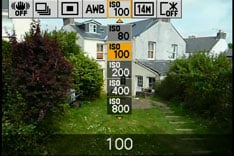 |
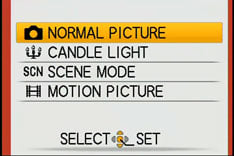 |
A second tab contains setup options including date and time (along with an option to set a second ‘destination’ time zone which is handy for trips abroad), power saving, image review, menu display size and card formatting. In playback mode the options include calendar view, test stamping, resizing, cropping, printing and copying. Slideshow options are available from the mode menu where we nearly missed them. With the exception of the super-imposed Q Menu, the FS30 / FH20’s menu design and architecture isn’t nearly as logical and intuitive as it needs to be.
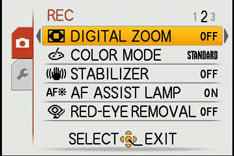 |
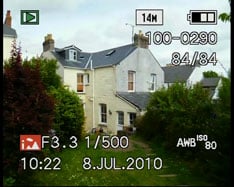 |
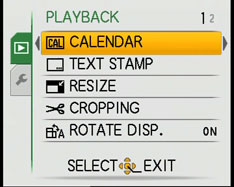 |
Some of the more frequently used menu settings can be accessed by pressing the Q Menu button. In Normal Picture mode they consist of stabilizer, burst shooting, AF mode, white balance, ISO sensitivity, picture size and LCD mode. As with the normal menus, these options are restricted in Intelligent Auto and scene modes.
The design of the Q menu works well though, with a super-imposed ribbon at the top of the screen with options for each setting appearing as drop-down vertical strips. Other than formatting, the Q Menu contains pretty much everything you’re likely to need for most shooting situations.
The Lumix FS30 / FH20’s Intelligent Auto shooting mode provides point-and-shoot automatic operation with scene detection to help select the optimal exposure settings. It’s unusual in that you can’t select it from any of the FS30 / FH20’s menus, instead there’s a dedicated button next to the shutter release that toggles it on and off – indicated by a beep and a screen icon.
Scene detection recognises six scene types – portrait, scenery, macro, night portrait, night scenery and sunset. It’s quick and accurate and works very well in most circumstances, though it faltered on occasions with backlit subjects and in low light is subject to the same limitations as face detection, particularly for the portrait modes – which automatically activate face AF.
What on most compacts would be called Program auto mode is known as Normal Picture mode on the FS30 / FH20. This is the mode that provides most control over settings – mostly selected from the Q menu as described earlier. While it doesn’t offer anything approaching full manual exposure control, you can at least set the ISO sensitivity.
There are no fewer than 25 scene modes to choose from including, in addition to those used for scene detection, sports, candle-light, two baby scene modes, pet, a high-sensitivity mode that takes 3 Megapixel images at sensitivities up to 6400 ISO, aerial photo and film grain. There’s also a ‘My Scene’ option which lets you assign your favourite scene mode to the mode menu for quick selection.
In Motion Picture mode the Lumix FS30 / FH20 can shoot 720p HD video at 30 frames per second. Three other modes are available – a widescreen WVGA mode measuring 848 x 480 pixels, VGA at 640 x 480 pixels and QVGA at 320 x 240 pixels. All video modes operate at 30fps. HD movies are encoded using a Motion JPEG codec and saved in a QuickTime wrapper with a .mov file extension.
Registered members of Vimeo can download the clip seen opposite for evaluation on their own computers.
Neither the optical nor even the digital zoom can be used during filming which means you’ll have to frame your shot with the optical zoom before pressing the record button. This puts the FS30 / FH 20 at a disadvantage compared to the Fujifilm FinePix JZ300 which has full use of the optical zoom during video recording. Being able to zoom whilst shooting isn’t as big a deal as it sounds, though. The main problems with the JZ300 being the tendency for the focus to wander and motor noise being recorded. When in Motion Picture mode the FS30 / FH20 automatically enables the image stabilizer in Mode 1 (continuous). As with all cameras that use a CCD sensor, video is prone to streaking (vertical colour bands) when shooting bright subjects, reflections on water for example, and into the light.
In Burst mode the FS30 / FH20 can shoot continuously at a little over one frame per second. In our test we couldn’t get it to match the claimed speed of 1.5fps and reducing the image size didn’t help. There is, however a high speed burst mode with a claimed speed of approximately 5fps which did manage to maintain that rate consistently. High speed burst mode limits the image size to 3 Megapixels or lower and tends to use high sensitivities.
The Lumix FS30 / FH20’s 14 Megapixel 1/2.3in CCD sensor produces 4:3 images with a maximum size of 4320 x 3240 pixels. It has several smaller picture size options including cropped 12.5 Megapixel 3:2 and 10.5 Megapixel 16:9. Images are compressed and saved as JPEGs, but there’s no control over the degree of compression used; best quality files typically occupy around 4.5MB. The shutter speed range is 8 seconds to 1/1600 with longer exposures of up to a minute available in Starry Sky mode. The camera has 40MB of internal memory, only enough to store a handful of shots, so you’ll be needing to fit an SD card at the earliest opportunity.
To see how the quality of the FS30 / FH20 measures-up in practice, take a look at our real-life resolution and high ISO noise results pages, browse the sample images gallery, or skip to the chase and head straight for our verdict.





